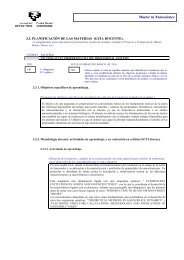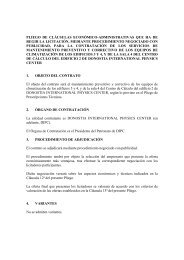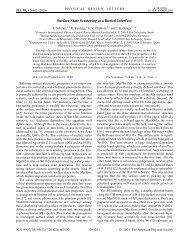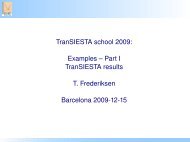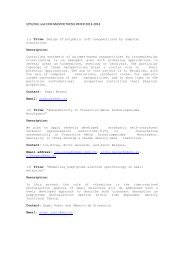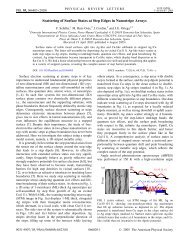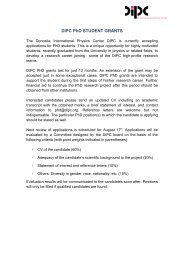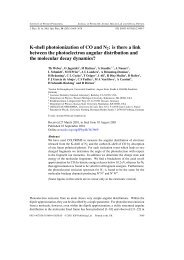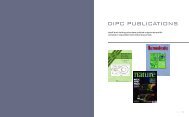Complete report - Donostia International Physics Center - Euskal ...
Complete report - Donostia International Physics Center - Euskal ...
Complete report - Donostia International Physics Center - Euskal ...
Create successful ePaper yourself
Turn your PDF publications into a flip-book with our unique Google optimized e-Paper software.
2011 DIPC Highlight<br />
Dye sensitized ZnO solar cells:<br />
attachment of a protoporphyrin<br />
dye to different crystal surfaces<br />
characterized by NEXAFS<br />
R. González-Moreno, P.L. Cook, I. Zegkinoglou, X. Liu, P.S. Johnson, W. Yang,<br />
R.E. Ruther, R.J. Hamers, R. Tena-Zaera, F.J. Himpsel, J.E. Ortega, and C. Rogero<br />
The Journal of Physical Chemistry C. 115, 18195 (2011)<br />
Figure 1. N1s absorption edge of<br />
different Protoporphyrin molecules<br />
attached to ZnO nanorods<br />
(full lines) compared to the molecular<br />
powders (dotted lines).<br />
Protoporphyrin dimethyl ester<br />
(esterH2PPIX) on ZnO is almost<br />
not distinguished, demonstrating<br />
the need of carboxylic groups<br />
for attaching molecules to ZnO<br />
efficiently.<br />
In this work, element-specific spectroscopy, particularly Near Edge X-ray Absorption Fine Structure<br />
(NEXAFS) spectroscopy, is used to investigate the chemistry and electronic structure at the<br />
interface between dye molecules and the ZnO acceptor electrode for dye-sensitized solar cell<br />
applications.<br />
Dye sensitized solar cells are becoming a serious contender for low-cost solar cells. To improve their efficiency<br />
it is necessary to find the optimal combination of organic dyes, electrolytes and nanostructured<br />
anode materials. The best performance so far is achieved with a TiO2 nanocrystal anode sensitized by<br />
ruthenium-based organic dyes. This design exhibits high quantum efficiency due to the fast electron injection<br />
process into the oxide conduction band. An alternative is a ZnO nanorod array, which has the ideal<br />
architecture to minimize the charge carrier path while keeping a large active surface. However, in ZnO<br />
nanorod cells, the overall efficiency is poor. One possibe reason is a poor attachment of the dye to the<br />
ZnO surface.<br />
With the aim of understanding the physical and chemical properties of dye-sensitized ZnO surfaces, we<br />
have analyzed the attachment of porphyrin molecules, such as free and metalated protoporphyrin, to the<br />
three low-index ZnO single crystal faces and to ZnO nanorod arrays, using near edge X-ray absorption<br />
fine structure (NEXAFS) spectroscopy. The selection of protoporphyrin was motivated by both the presence<br />
of carboxylic acid anchoring groups, and the structural simplicity, i.e., a planar geometry that allows structural<br />
characterization of the bonding through light polarization studies at the N 1s edge in NEXAFS.<br />
Using this approach we have confirmed the importance of carboxylic groups in the anchoring of the molecules<br />
to the ZnO surfaces, similar to the situation on single crystals as Cu(110). By comparing results obtained<br />
for molecules with two propionic acid groups and molecules where the carboxylic acid groups have<br />
been replaced by two ester groups, the last did not immobilize on the ZnO surface (illustrated in Figure 1).<br />
Moreover, we have found that the crystallographic orientation of the exposed ZnO face has a strong influence<br />
on the dye immobilization (illustrated in Figure 2). The O-terminated ZnO(0001) surface provides<br />
the maximum total uptake, and molecules are oriented such that the central macrocycle ring is perpendicular<br />
to the surface, as determined from the polarization dependence of NEXAFS. The non-polar Zn(10-<br />
10), which makes up the lateral facets of the nanowires, exhibits a lower uptake and much less polarization<br />
dependence. This can be interpreted as non-optimal anchoring, and could explain the poor efficiency of<br />
ZnO cells fabricated with nanowires instead of nanoparticles. Finally we determine that different chemical<br />
immobilization conditions produce etching on the ZnO surface. This could strongly affect to the efficiency<br />
of the possible organic cell device.<br />
ZnO nanorod arrays<br />
are desirable for<br />
organic photovoltaic<br />
devices because<br />
of the high crystallinity<br />
and the optimum<br />
architecture.<br />
Figure 2 cross section SEM micrographs of the ZnO nanorods showing a<br />
dense array of roughly hexagonal columns. Polarization-dependent N 1s<br />
absorption edges of H2-Protoporphyrin IX on the three low-index ZnO single<br />
crystal surfaces and for ZnO nanorods. Red lines are for a polarization<br />
parallel to the surface and blue lines for mixed polarization. The (nominally)<br />
oxygen-terminated ZnO(000-1) surface exhibits the strongest polarization<br />
dependence and the highest coverage. Inserted is an illustration of the configuration<br />
of the molecule standing upright on the ZnO (000-1) surface.<br />
74 DIPC 10/11<br />
DIPC 10/11 75



